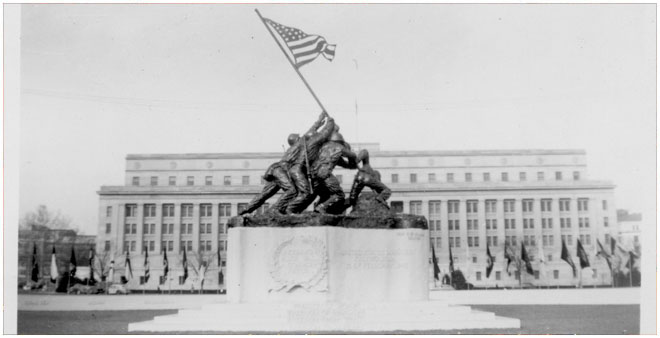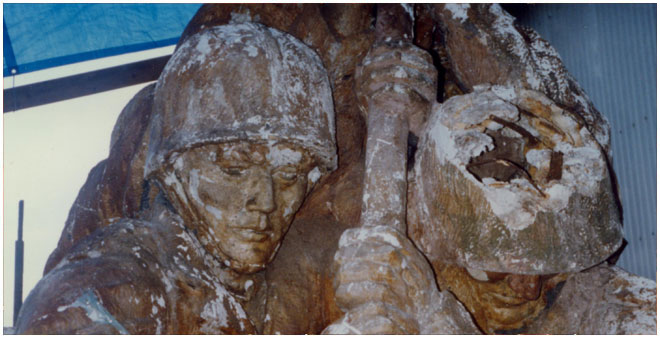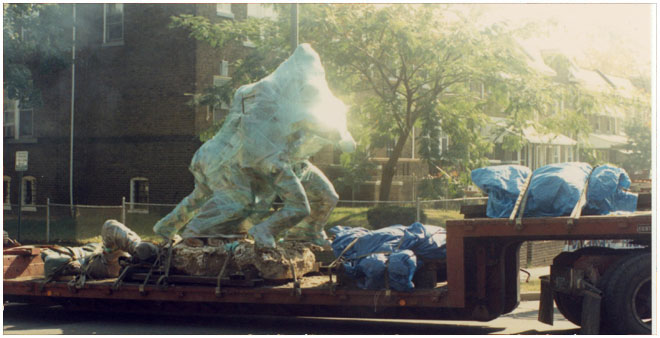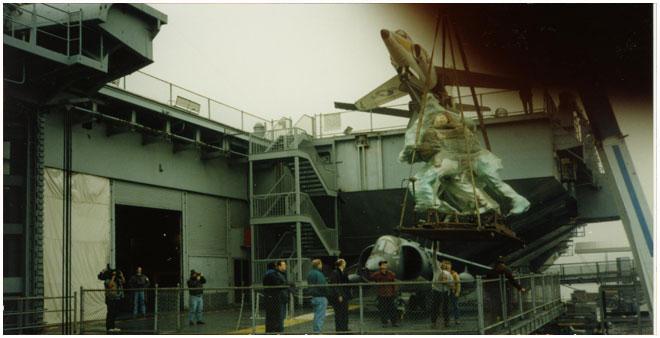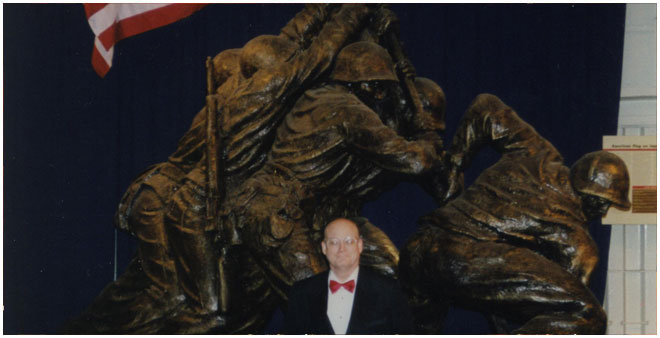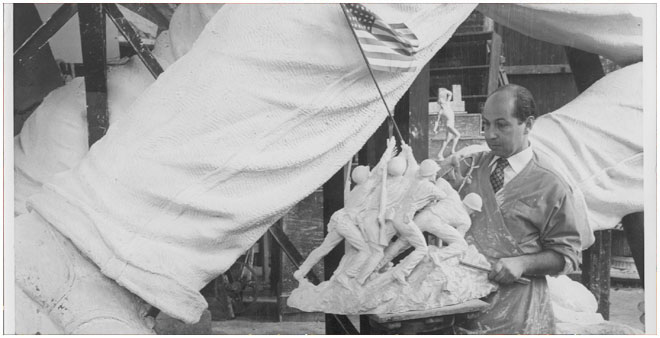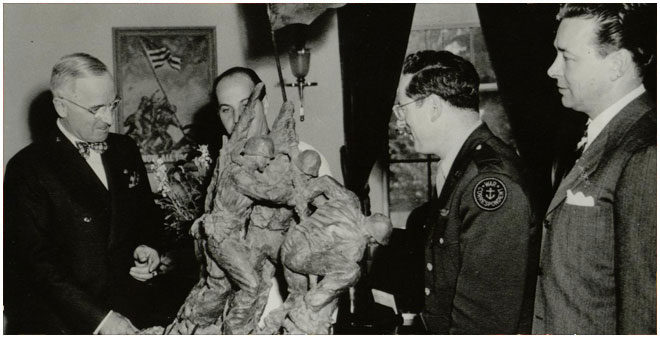The War Museum
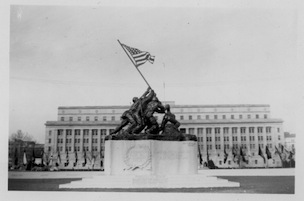 IWO JIMA STATUE SURVIVES
IWO JIMA STATUE SURVIVES By Sgt. Jeffrey Castro
NEW YORK CITY (Jan. 24) — Undoubtedly one of the most powerful images of the 20th century is the flag raising atop Mount Suribachi on Iwo Jima. A sacred symbol of the U.S. Marine Corps, captured by photographer Joe Rosenthal, it is regarded as one of the most recognizable images in the world.
As with most things in the Marine Corps, there is some history behind the original Iwo Jima statue, which was the model for the current memorial in Arlington, VA. and where the original has ended up. For more than 35 years, a man has searched for military artifacts from the Civil War to the present day. Not for money or for glory, but for the simple idea that history is important, he has resurrected pieces some thought lost and according to him, he found his greatest prize in 1990.
Rodney Hilton Brown, president of a New York based mortgage-banking and investment advisor company, also claims another title to those that know of his lifetime hobby -”Indiana Jones.” Thousands of his finds have been on display in museums such as the Smithsonian Institute, the National Portrait Gallery, the United Nations and the Naval War College Museum.
“When I was nine years old I was interested in military history and started collecting guns, swords, whatever I could find,” Brown said. “I went around and knocked on doors asking people if they had any old guns, swords or military memorabilia in their attics that they did not want anymore. I have been collecting ever since ? and I believe I have one of the largest collections of Marine Corps memorabilia.”
His quest to find the original Iwo Jima statue began with a photograph and a dream — literally. Brown saw a photograph of a smaller flag raising model created by Felix de Weldon, which he crafted out of wax only 48 hours after the flag raising took place. Originally, Brown was after this smaller statue, but once he recovered it, he learned there was a larger prize to be found and changed his focus to the larger Iwo Jima monument. “I had a dream one night about it and I knew it existed,” said Brown. “But no one really knew where it was, even the sculptor, Felix de Weldon. His last memory of it was that it was thrown away.”
Behind the eagle, globe and anchor, the flag raising has taken the form of a second emblem for the Marine Corps within the culture of the Corps. From T-shirts, plaques and birthday ball centerpieces, to the Iwo Jima Memorial statue in Arlington, the image has deeply rooted itself within the Marine Corps.
Brown did more research and found that after it was taken off display in front of the Old Navy Building in Washington, D.C., where it stood from 1945-1946, the 10-ton statue was placed on a truck and went on tour around the country helping to promote war bonds. After that, the history of the statue is clouded by time and for almost half a century, its final resting-place was unknown. All he could go on was its last known whereabouts, which according to the sculptor, was in his abandoned 18th century studio in Washington D.C.
“I got into the building and the place was a mess,” said Brown. “A hole in the roof let water seep in and it rotted the wooden floor. After looking around the yard behind the building, I saw a tarp covering an object that was resting in the mud and covered by fallen trees. I cut open the tarp and there it was.”
Brown said the statue was in pretty bad shape after sitting there for more than 40 years. Three heads were severely damaged; parts of the plaster and cement statue had completely crumbled away leaving the exposed steel skeletons of the figures and gaping holes riddled the entire sculpture. Brown and his crew spent more than a week meticulously pulling pieces of the sculpture from its muddy grave. After collecting the pieces, they were transported to a workshop in Princeton, N.J. where the arduous task of restoring the statue began.
Brown admitted that he was skeptical of the whole endeavor at times and was told by numerous people working on the project that it would be cheaper to just make a replica of the statue than to repair the old one, but Brown never entertained the thought.
“This is the original, it has to be restored,” Brown said. “I feel that it is historically important to the country and it must be saved.” Brown enlisted help from the original foreman of the project, 85-year-old Bill Petsco, who directed the restoration.
The painstaking restoration was done using period photographs of the statue supplied by the National Archives and de Weldon. Eventually, after five years of labor and approximately $300,000 the statue was complete. From the studio in New Jersey, the statue was taken to the Intrepid Sea, Air and Space Museum in New York for finishing touches where it was to be displayed for the first time in 50 years.
On Feb. 19, 1995, exactly 50 years since the flag raising on Iwo Jima, the statue was unveiled to the public by LtGen. R.D. Hearney, Assistant Commandant of the Marine Corps. “That battle came to symbolize all that is good about our country and our Corps,” Hearney said. “The story should be told again and again to our children and our grandchildren. It is a story simply about courage.”
Among the crowd were Marines who fought on Iwo Jima and emotions ran high that day according to Brown. “Tears where rolling down the deck of the ship,” Brown said. “It is one of the most important statues in our country, second only to the Statue of Liberty.”
Bringing the statue to the public allows them to view a piece of our history and bring it alive Brown added. “I want people to see it. it is inspiring because they see real life, and it triggers something inside them. I want people to look it and take away something with them.”
Since then, the statue has held a place of honor aboard the Intrepid and has been seen by more than one million visitors. Asked what his ultimate prize would be, Brown took a moment. He leaned back in his chair and thoughtfully surveyed his office high above the city, which looks more like a military shrine rather than a mortgage office. Adorned with autographed photographs, plaques and other military decorations, the walls are a colorful mosaic of his lifes work. He breathed deep, smiled and said, “The Iwo is it.”
